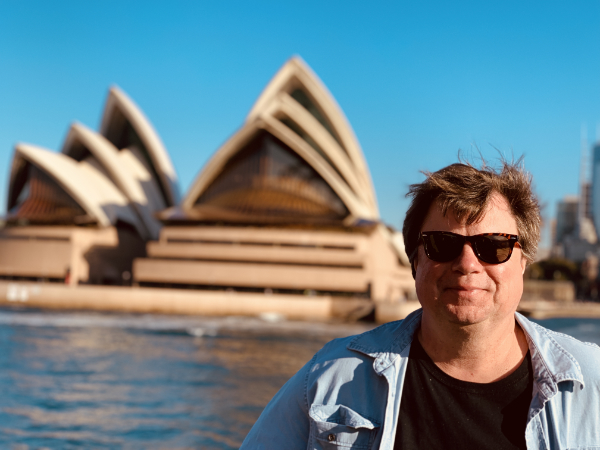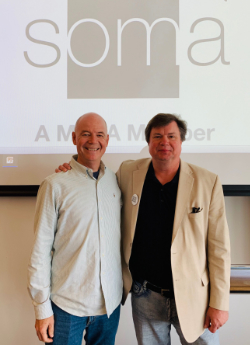I have long felt a kinship with the musicians of Australia’s orchestras. I first met the leadership of the Symphony Orchestra Musicians Association of Australia (SOMA), when soon-to-be-president Tania Hardy-Smith visited the ICSOM Conference in San Diego in 2005. Out of that first meeting grew a long friendship that would flourish through multiple international orchestra conferences in Berlin, Oslo, and Amsterdam, where I met more of the leadership of SOMA and their union, the Media Entertainment & Arts Alliance (MEAA). It was an honor to welcome the current president of SOMA, Mark Bruwel of the Opera Australia Orchestra, at the 2016 ICSOM Conference in Washington, DC. For many years we had discussed finding an opportunity for me to visit with the musicians of Australia. So when Mark invited me to be the keynote speaker at the SOMA Conference in Sydney this August, I was thrilled beyond expression.

The author in front of the Sydney Opera House
Photo credit: Courtesy of the author
About 45 years ago, when I was growing up on the Outer Banks of North Carolina (at the time so remote that there were signs in the cottages with instructions for television reception that read “TV channels: 3, 10, and 13…weather permitting”), I remember watching a broadcast from the newly-opened Sydney Opera House on a blurry black and white TV set. I don’t recall just what event was being broadcast internationally, but I could see the beautiful building, and it became emblazoned in my memory. To attend a spectacular presentation of Madama Butterfly in that same opera house was an emotional experience for me.
The beauty of the Opera House, shimmering in the sun as it sits on Bennelong Point on Sydney Harbour, is nothing short of breathtaking. (As Bill Bryson noted in his book In a Sunburned Country, life cannot offer many places finer to stand than Circular Quay in Sydney.) The building is one of the most famous structures in the world, but standing by the harbor it seems even larger than what can be imagined from photographs. I’ve been told that seven A380 airplanes could sit wing-to-wing on the site. More than ten million people visit the Opera House every year for hourly tours and to attend events at the venue’s multiple performance spaces.

Mark Bruwel and the author
Photo credit: Paul Davies
The meeting of SOMA was held at Rushcutters Bay in Sydney, and was attended by representatives from the orchestras of Adelaide, Melbourne, New Zealand, Opera Australia, Queensland, Sydney, Tasmania, Victoria, West Australia (Perth), and the Australian Ballet, as well as the leadership of MEAA. Each orchestra had approximately five members in attendance. The theme of the conference was advocacy, and I participated in a panel discussion with Emma Dunch, the CEO of the Sydney Symphony Orchestra, titled Advocating our Art. There is an ongoing need in Australia, as everywhere, for musicians to continue to be their own strongest advocates. In Australia, there is considerable governmental funding for orchestras and the arts, but the amount of support varies from orchestra to orchestra.
SOMA consists of approximately 550 members from eight orchestras, and was in some ways modeled after ICSOM at its founding. Nearly 100% of the musicians in its orchestras are members of SOMA, and the organization serves its members in many ways, including communication and advocacy, as well as through the production of its excellent magazine Senza Sord.
A survey conducted by MEAA this summer found that there is strong support for public funding of orchestras in Australia, with 83% of people saying funding should either stay at current levels or be significantly increased. 48% of respondents identified orchestral music as an important part of Australia’s culture, and 70% agreed that orchestras are an important part of the economy. Over 50% expressed that it is important for school children to learn classical music. But regrettably, the survey also found that a majority of Australians did not attend a live entertainment event in the last 12 months.
In my keynote address to the conference, I expressed that in a time of incivility, our music remains more relevant than ever, and in our troubled world, humanity will always persevere in the face of violence. Music will forever be a response to hatred. Musicians can lead the way by continuing to offer an elevated message of hope. In doing so, the world will surely benefit, as will musicians everywhere. Musicians always must stand for peace, and we must take action with our art to bring compassion to those who are hungry, alone, suffering, and discriminated against.
I arrived in Sydney just days after two mass shootings in America. It wasn’t a subject I felt I could avoid, having been offered this international forum to discuss the importance of music to society. In the inevitable hand-wringing that always follows such gun-related incidents, pundits speculate on how we might respond. To me it seems clear one element of the problem is that in certain areas of America it is easier for a child to get a gun than a trumpet, and in many neighborhoods children grow up with a greater familiarity with the sound of gunfire than with the sound of an orchestra. We must invest in the early years of a child’s life, as no education is complete without music. By bringing music and hope to the lives of young people, we not only are working to create a new generation of audiences, we are also helping to create socially aware citizens of the world who may be able to lead the world to a greater understanding, and a new era of peace.
The conference featured several tributes to Richard Gill, a beloved music educator and conductor who passed away last year. He was a strong advocate of music education for children, and I was moved by the many recollections of his work and kindness offered by musicians from across the continent.
Throughout my visit the kindness and compassion of the Australian people impressed me everywhere I went. A presentation at the conference by Support Act expressed that sense of compassion. Support Act, as described on the website, is “a charity, unique in Australia, helping artists and music workers who are facing hardship due to illness, injury or some other crisis that impacts on their ability to work in music.” Among the many services for musicians who may be in need is a 24-hour free and confidential helpline. Such a program could be of value in every country. The message from the vision statement expresses, “We are service driven. We act with dignity and integrity. We care for our community. We foster positive relationships. We believe in continual improvement. We will always deliver help without judgment and with compassion, working to the highest possible professional standards. We will embrace and drive change, be nimble in our approach and we will surpass expectations.”
Another example of the compassion of musicians in Australia is the Concert for Life, an event that marks World Suicide Prevention day, organized by members of the Sydney Symphony and the Australian Chamber Orchestra. This year’s event, as reported in Limelight magazine (a beautiful nationwide publication that serves as Australia’s classical music and arts magazine), will raise funds for Indigenous suicide prevention.
Efforts are being made throughout Australia to recognize and honor the Aboriginal people, and many buildings have signs that acknowledge that the site actually belongs to a particular Aboriginal group. In some areas of the nation an “acknowledgment of Country” can be made, with wording along the lines of “I acknowledge the Traditional Owners of the land. I pay my respects to their Elders, past, present, and emerging.” In Sydney, events such as the SOMA conference now begin with a “Welcome to Country” led by a recognized elder of the welcoming group.
I was also fortunate to attend a concert of the Sydney Symphony Orchestra, led by Music Director David Robertson, at Town Hall in Sydney, a beautiful building which opened in 1889. (The orchestra will perform there next season, when renovations begin on the concert hall at the Sydney Opera House.) It was an impressive performance in a beautiful setting, and I consider myself the luckiest musician in the world to have had an opportunity to hear so many of the world’s great orchestras in my travels for ICSOM and for arts advocacy. I hope I will find more opportunities to take a positive message across the world, and that I might continue to build friendships with musicians on multiple continents.
I want to offer my thanks to my great friend Mark Bruwel and all the musicians of SOMA as well as the leadership of MEAA for this invitation. I also want to thank Meredith Snow and the ICSOM Governing Board for their support. It means a great deal to me that I still have opportunities to spread ICSOM’s message of hope and advocacy through my travels.
Note: The author is a former ICSOM chairperson. His keynote address to the conference of the Symphony Orchestra Musicians Association of Australia can be read at https://www.meaa.org/news/the-healing-power-of-music/.





